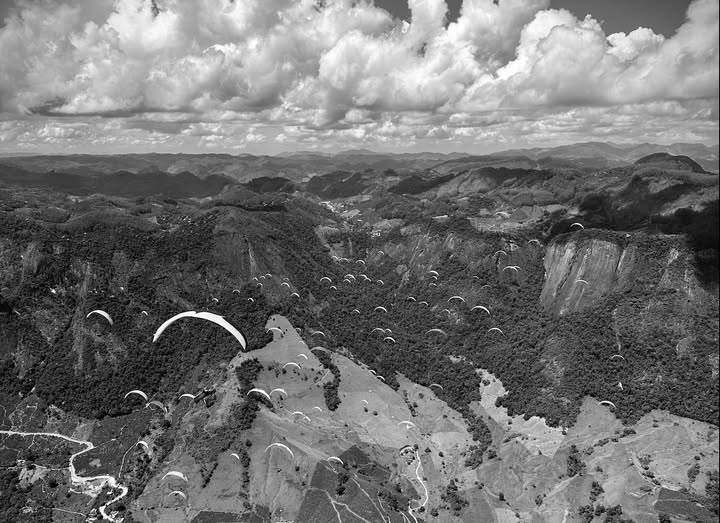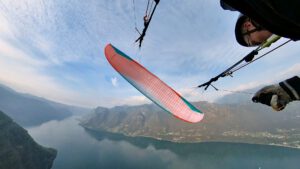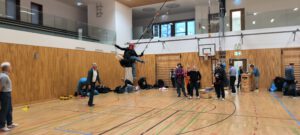Pál Takáts wrote an open letter on Facebook suggesting that competitions should only be held with EN-C gliders in the future. This has led to heated discussions on various platforms, mainly on Facebook. Keeping track of the pilots’ opinions is naturally difficult, so I summarized all comments from Facebook (as of September 26, 2025) using ChatGPT.
The open letter and comments can be read at facebook here (logon is not necessary). I have revised and anonymized the results. The following statements are the opinions of the respective pilots, and artificial intelligence tends not to reproduce things correctly. Therefore, the following statements should be viewed critically.
Summary Pál Takáts open letter
- Normalization of accidents
- Fatalities and serious injuries occur frequently at high-level competitions.
- These events are often downplayed or ignored by organizers and federations.
- Lack of transparency: Information about incidents is difficult to obtain without insider contacts.
- Institutional priorities
- Money, politics, and prestige often outweigh safety considerations.
- Some venues (e.g., China event) were knowingly unsafe due to terrain and conditions.
- Historical precedent
- Piedrahita 2011: two fatalities in the World Championships led to cancellation of the event and the end of Open Class (non-certified) wings → CCC class introduced.
- This was the last radical safety reform; since then, accidents persist without major structural change.
- Personal reflection
- Earlier willingness to risk death for passion replaced by rejection of that mindset.
- Emphasis on the impact of loss on families and the community.
- Task & Competition Structure
- Avoid organizing competitions in risky sites or at unsafe times of year
- Task/safety committees should be empowered to stop tasks earlier when multiple Level 3 calls are made.
- Introduce new race formats to reduce “full bar” flying and lee-side risks, e.g. penalties instead of mandatory cylinder crossing, or altitude-based ESS/goal definitions.
- Implement altitude clearance rules for cylinders or terrain to reduce unsafe low flying.
- Update scoring systems to penalize excessive low flying or unsafe conditions.
- Equipment Standards
- Debate around whether competitions should use EN-C, EN-D, or CCC gliders:
- Some propose limiting to EN-D for more passive safety.
- Others argue conditions and tasks, not gliders, are the main issue.
- Concerns that moving comps to EN-C would push unsafe “edge” designs in that class.
- Calls for better harness design and R&D.
- Standardization of tracking devices as mandatory safety equipment.
- Debate around whether competitions should use EN-C, EN-D, or CCC gliders:
- Training & Education
- Mandatory annual SIV training for high-level comp pilots, subsidized by federations.
- Suggestion for training programs for organizers to improve decision-making and task setting.
- University-led research studies to summarize historical accidents, incentives, and international best practices.
- Transparency & Reporting
- Mandatory incident reporting and publication, similar to USPA’s monthly analysis.
- Centralized accident/incident database to identify trends and inform reforms.
- Automatic post-competition surveys for pilots to rate safety and provide feedback.
Summary of the pilot’s comments
Proposed Safety Reforms
- Equipment & Training
- Mandatory GPS satellite trackers (independent of cell networks).
- Proof of pilot competence (e.g., video evidence of stalling CCC wings).
- Reduction of harness complexity and redesign for spinal protection.
- Competition Structure
- Limit World Cup and CAT1 events to EN-C class (Sports Class).
- Introduce a new EN-B beginner category to replace current Sport class.
- Trial EN-C limitation for one season to evaluate outcomes.
- Cultural Shift
- Encourage open discussion on safety over performance obsession.
- Break silence within the community, as many privately agree but don’t speak up.
- Wing classification changes
- Calls to restrict competitions to EN-C wings rather than CCC for greater safety and accessibility.
- Some propose further splitting competition categories to allow EN-B pilots to participate.
- Harness and equipment regulations
- Concerns about unsafe “submarine” harnesses with poor protection.
- Proposals for mandatory SIV certifications on the actual glider used in competition.
- Ideas for technological safety systems, e.g. auto-deploy reserves based on vario/GPS sensors.
- Competition organization
- Safer task-setting and site selection (avoiding dangerous wind, rotors, leeside routes).
- Stricter infrastructure standards: launch quality, adequate marshals, safety support.
- Accident data reporting, mandatory debriefs, transparent investigations.
- Stricter trim checks and “parc fermé” rules to prevent wing tuning/cheating.
- Insurance & support
- Organizers/federations should provide medical insurance for all pilots.
- Cultural changes
- Redefine competitions to reward safety margins (e.g., scoring points for keeping distance from hazards).
- Reduce emphasis on “marketing wings” and social media exhibitionism.
Support & Contributions from Other Experts
- Community Suggestions
- Competition Format & Scoring
- Reward altitude and line selection rather than low, risky speed-bar pushes.
- Introduce PEV (Pilot Event Marker) system from sailplane competitions to avoid mass gaggles.
- Equipment Innovations
- Use new protective materials (e.g., D30) in harnesses.
- Limit ballast weight.
- Explore design changes (e.g., anti-collapse).
- Safety Standards
- Set minimum standards for gliders, harnesses, reserves, and pilot skills.
- Enforce strict safety criteria for venues.
- Training & Transparency
- Compulsory stall/recovery training for CCC pilots.
- Public reporting of all incidents and accidents to allow collective learning.
- Competition Format & Scoring
- Recognition that fatalities are often hushed up, limiting open discussion.
- Multiple voices highlight task setting and weather decisions as the critical safety factors, not only equipment.
- Broad agreement that preventive safety should be emphasized, not just post-incident fixes.
- Endorsement of cultural changes:
- Encourage self-reflection among pilots who push limits.
- Shift from “performance at any cost” to valuing safe returns.
- Historical comparisons:
- Other sports adapted successfully after banning unsafe equipment.
- Spot-landing competitions or alternative formats could reduce performance-driven risk.
- Many pilots voice respect and support for sparking this difficult conversation.
- Many agree with Pál Takáts’ position that safety must come before performance and marketing.
- Historical precedent: Robbie Whittall and others pushed to ban open class in the 1990s for similar reasons.
- Recognition that manufacturers currently prioritize aesthetics/marketing over safety.
- Comparisons with Formula 1: technical restrictions improved both safety and the sport.
- Some argue EN-D era (before CCC) was safer, more fun, and more about pilot decisions than wing risk.
- Experienced pilots confirm: the sport produces too many fatalities; stronger regulation is overdue.
- Positive reception to proposals for EN-C level comps, accident analysis, and cultural change.
Divergent Opinions
- Some pilots favor maintaining CCC wings with stricter pilot training and better rules.
- Others highlight environmental and organizational factors (venue selection, weather conditions, group pressure) as more critical than wing classification.
- Concerns raised about EN-C direction (trend toward high-aspect two-liners).
- Skepticism about EN rating reliability due to subjectivity and political/economic pressures.
- Glider Category Debate
- Some advocate EN-D as the minimum standard.
- Others argue EN-C limits would worsen safety or distort design.
- Some say equipment is secondary; main risks are task setting and conditions.
- Role of Risk
- Some accept that paragliding competitions will always be inherently high-risk, and regulation has limits.
- Others argue that culture and mindset are as important as equipment or rules.
- Responsibility
- Pilots themselves share blame for ignoring warnings and chasing performance.
- Others stress organizers’ duty to cancel/stop tasks sooner.
- A few note lack of compassion/empathy in the competition culture, reinforcing systemic issues.
- Against blaming equipment/manufacturers alone
- Some insist the core issue is pilot ego, risk-taking culture, and individual responsibility.
- Comparisons to SUVs/guns: tools are neutral, risk comes from how people use them.
- Skepticism about EN-C reforms
- Risk that manufacturers will push EN-C designs to dangerous extremes, as happened with EN-D before CCC.
- Concern that restricting to EN-C may destroy the class through overdevelopment.
- Some argue harnesses and unsafe task settings are bigger problems than wings themselves.
- Caution against over-regulation
- Stricter safety rules in France led to fewer accidents but also “killed” competitions due to bureaucracy.
- Some fear external regulators (lawmakers) may intervene if the community cannot self-regulate.
- Cultural divide
- Some reject competition entirely as inherently ego-driven, unsafe, and diminishing individuality.
- Others defend competition as a valuable learning tool if approached with the right mindset.
Broader Reflections
- Cultural divide: between those prioritizing performance/glory vs. those prioritizing safety.
- Historical parallels: motorsport evolution shows safety can advance without killing competitive spirit.
- Participation trends: Some pilots leave competition entirely due to safety concerns, others move down to EN-B/C wings for peace of mind.
- Momentum for change: Multiple respected figures and “retired legends” support EN-C limitation and broader safety reform, suggesting a potential turning point.
- The culture of silence around accidents undermines collective learning.
- Human psychology and ego will always push pilots toward limits, making total risk elimination impossible.
- The sport’s evolution is shaped by sponsors, media, and performance incentives, which often run against safety.
- Veteran perspectives:
- Nostalgia for a time when community spirit was stronger, before politics and equipment showmanship.
- Long-term pilots mourn the many friends lost over decades of competition.
- Skepticism that gear restrictions alone can resolve systemic safety challenges.
- Personal philosophies
- Many experienced pilots state they quit competitions to preserve long-term enjoyment of flying.
- Some emphasize flying as personal fulfillment, not proving worth or taking extreme risks.
- A recurring sentiment: better to live enjoying flying than die doing what you love.
- Human factors
- Immaturity, lack of recency, or flying above one’s skill level are key contributors to accidents.
- Ego, exhibitionism (especially for social media), and disregard for weather limits worsen risks.
- Community responsibility
- Collective pressure needed on manufacturers, organizers, and federations to prioritize safety.
- Acknowledgment that fatalities traumatize families and damage the image of the sport.
- Historical cycles
- This debate has recurred for decades: open class bans, CCC introduction, repeated calls for reform.
- Despite incremental changes, high fatality rates continue—showing systemic problems remain unresolved.
Key Takeaway
The open letter by Pál Takáts has catalyzed a significant debate within the paragliding competition community. This discussion highlights real courage in confronting a taboo subject: the human cost of paragliding competitions. Consensus exists on the need for systemic safety reform, but proposed solutions diverge across:
- Wing class restrictions (EN-C vs. CCC)
- Scoring/competition format changes
- Equipment innovation
- Venue and organizational standards
- Reform must go beyond equipment categories to address task design, safety culture, transparency, and organizational responsibility.
- Multiple concrete reforms are possible—reporting systems, training programs, altitude-based scoring, and safer task setting—but all require collective will.
- Ultimately, paragliding will remain risky, but preventive safety culture and honest dialogue are the community’s best tools to reduce fatalities and protect its future.
- Many experienced voices—including Pál Takáts—call for resetting competition safety standards, especially by moving to safer gliders (EN-C), improving organizational practices, and building a stronger safety culture.
- Divergent views remain: some blame wings and manufacturers, others focus on task setting or pilot ego.
- What unites the discussion is recognition that the current balance between performance, marketing, and safety is unsustainable—and without reform, lives will continue to be lost unnecessarily.
Despite disagreements, the discussion indicates growing alignment that the status quo is unsustainable and that another “safety revolution” is overdue.





